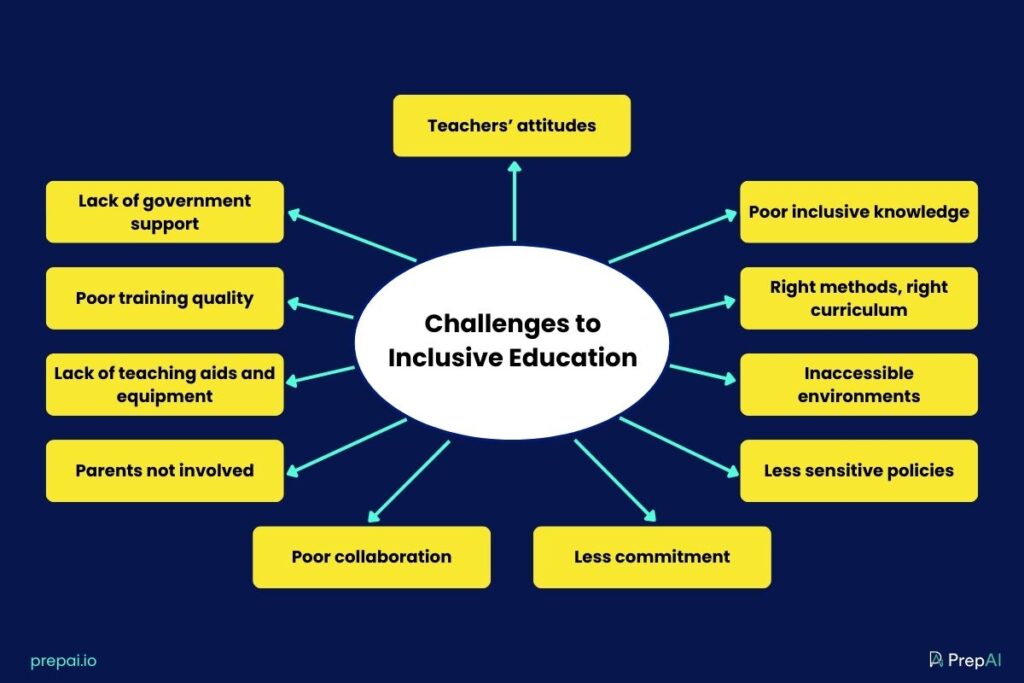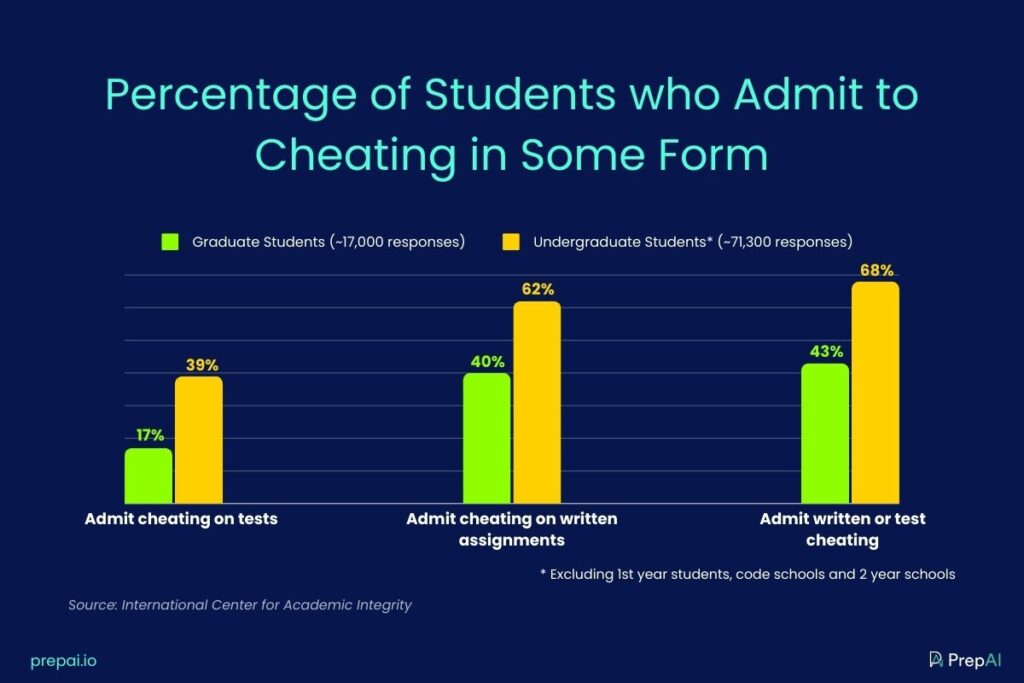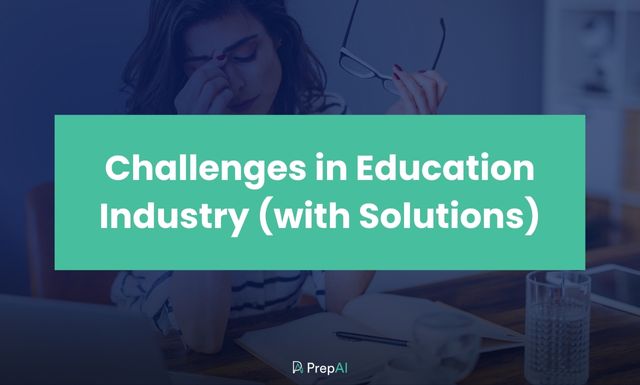Stats report that 65% of educators across the globe are looking for ways to make their lectures more engaging and employ modern digital solutions for teaching. The reason is the competition to leave a mark amongst the top players providing the best education services.
Furthermore, the EdTech software market is projected to register a (CAGR) of 19.9% from 2021 to 2028. Further, if the projections are realized, the revenues would show year-on-year growth of more than 200 million dollars.
While stats and the popularity of EdTech are painting an interesting picture, the ground reality is still in stark contrast. Educators across the globe are still stuck with the age-old syllabi, traditional evaluation methods, and effort-hogging paper generation routines that are loaded with redundancy.
Also, there are a number of administrative and institute management-related challenges faced by the administrators, as shown in the visual below:

Challenges in the Education Industry: The Post-COVID Reality
The post-COVID lockdown scenario in the education industry is teeming with various challenges. The primary challenge is the imbalance between the efficiency, the pace of learning, quality, and overall learning experience in offline and online classes.
There is a huge demand for lifelong learning to cope with social and technological changes. The educational institutions are creating literate people with immense skill gaps, leading to unemployment or mismatched careers.
While the world is getting revolutionized with technology and disruptions at a break-neck pace, educational institutions are still teaching about ancient processors. Adaptation is the key to both technological advancements and accountability.
Further, the educators are stuck with the time and effort-consuming test paper creation while grappling with the management of educational institutions in the light of pandemic-enforced digitization.
Here, we discuss the top challenges faced by the educators and education industry in general, and how EdTech software solutions can help to overcome them.
11 Challenges Educators and Education Industry Face
1. Current Education System Falters in the Light of the Fourth Industrial Revolution
While the world is teeming with industrial disruptions and every day brings some new technological advancement, the education system suffers from obsolete methodologies and education content.
Industry experts suggest that we need to focus on three Es – Education, Entrepreneurship, and Employment; along with the three Rs – Reading, Writing, and Arithmetic.
All the benefits from the Fourth Industrial Revolution stem from broad skill sets that take a long time to be acquired in the current education system.
This has spurred many innovative learning platforms and sources, such as:
- Massive Open Online Courses (MOOCs), for example, Coursera and Edx
- Podcasts
- YouTube Videos
This shift in learning has occurred because the emergence of hybrid learning sources can help young professionals acquire multidisciplinary skillsets and reduce their reliance on linear skills. This will come in handy in managing employees and labor from multiple backgrounds and enable them to leverage technology to make everyday jobs easier, more streamlined, and value-driven.
However, the large-scale adoption and embracing of such learning sources are still going to take a lot of time and granular penetration of new-age learning is still a far-fetched statement.
Solution:
While the change of syllabus and book content in the government institutions is still going to take some time to be changed, the teachers can themselves choose to introduce the students to new things.
Further, they can promote self-learning from open educational sources to prepare their students for the modern employment market.
2. Boredom and Mundane Nature of Teaching
Studies reveal that one out of three teens in America is bored most or all the time in school. Further, 80% of the students feel stressed and 34% feel depressed. And all these issues can find their roots in boredom and the mundane nature of teaching.
What makes the entire scenario gloomier is the fact that the evaluation procedure for the students continues to be the same for ages. The students who are unable to write fast, or describe things or events properly lag in terms of score.
However, eventually, these scores carry no paramount significance in the advanced stages of a career, as most exams tend to be objective in nature. Hence, there is a dire need for proper and modern evaluation and testing procedures that focus on gauging the actual learning a student has acquired.
Solutions:
Using interactive devices and educational resources will resolve the student boredom issues.
Instead of writing things and reactions down, calling them over to the labs and showing them the actual process, or sharing the video links to the demonstrations available online is a better option.
3. Technical Issues
The COVID-19 pandemic has shown multiple technology challenges the education sector is suffering from. From teachers grappling with the basic controls of online collaboration software, to the ones that face a tough time in sharing or creating digital files, there is a whole other stratum of challenges that still need to be addressed.
Some of the most crucial technological challenges faced by the education sector are:
Professional Development
There is a huge skill gap between the graduates and the professionals the modern employment sectors require. Further, this lack of professional development is for the teachers as well because they lack proper training and resources to integrate modern technologies into classroom teaching.
Lack of Personalized Learning
Judging every student via a single exam is no longer relevant; especially when the objective examination process is gaining popularity across the entire globe. Also, there is a lack of technologies that can help teachers impart personalized learning, in a limited period of one class.
Hence, there is a grave need for personalization in education. After all, someone with an interest in finance is not going to use Organic Chemistry synthesis concepts later in life.
MOOCs and New Models of Schooling
While there are several open-source learning platforms and sources of education, the new models of schooling are still going to take a long time to get conceptualized. There is no standardization in MOOCs and other academic content available online, and the educational institutions are still not aware of such educational resources that they can use for teaching.
Hence, the transition in the education sector is inevitable and there are some major drivers of this transition.
Solutions:
In case the educational institutions are not able to procure the modern educational content for the students, the teachers can share the sources for the same.
Even if the number of homes and educational institutions with computers is few, especially in developing countries, the digital and internet penetration is massive in the case of smartphones.
Hence, the teachers can help students use them for enhancing their educational and personal skills.
4. Assessment Strategies
As mentioned earlier, assessments have always remained a major challenge for educators with questions getting repeated for decades, evaluation methodologies remaining the same, and unequal evaluation being rampant.
While several exams are now MCQ-based or objective in nature, a multitude of them is still subjective. Also, there is a weak relationship between learning outcomes and assessment and the students have no right to “know” whether they are assessed properly, or “how” they are assessed.
Current assessment methods are vulnerable to bias as there is no transparency in the evaluation process and prompt feedback on assessed work is still missing from the scene. Classroom assessment techniques are less authentic, and the students never get to know whether there was a mix-up or not.
Hence, in this segment, technological intervention is highly required!
Solution:
There is a huge need for revamping the evaluation methodologies at scale. As the world is moving towards the digital transformation of the core sectors, the education stakeholders including the government must think of ways to make the youth ready for that.
5. Expensive Modern Technology Infrastructure
Adopting EdTech is easier but facilitating funds for mass adoption is certainly a daunting task. Further, most of the modern technological infrastructure is out of the budget of a majority of educational institutions.
A recent report revealed that 37% of the teachers in various institutions have taken it upon themselves to facilitate EdTech for their students. They get whatever equipment they feel is important by spending money out of their own pockets.
While this is certainly a noble initiative, it is not a solution.
Solution:
The government and angel investors can pick the institutions and facilitate the EdTech equipment that can be rotated among the educational institutions in a district.
educational institutions can simply leverage the technology they already have, such as laptops and computers, and use the free open-source educational material available online.
There are many websites that offer quality EdTech solutions for free as well. Promoting the BYOD (Bring Your Own Device) culture can enable teachers to bring their devices to the school and use them for promoting modern education.
6. Question Paper Creation
The process of creating question papers hasn’t changed for ages, the only difference being that the teachers are now creating question papers on the computer. They have to make the questions themselves, and because of the obvious limitations of humans, the questions get repeated and many times, teachers frame questions wrongly.
While these issues are not significant in smaller education levels, such as schools, they become crucial when it comes to entrance exams. Hence, these exams are checked by the exam moderators and subject matter experts for maintaining integrity and correctness.
This again adds to the operational overheads and makes the entire process time-consuming, lengthy, and subject to leaks.
When it comes to classroom teaching, there is almost no variety in assessment tests and students get tested only for those concepts that a teacher considers important.
So, there are considerable pitfalls and challenges in this segment. Further, even if large-scale technology adoption is done via a question paper generator, the cost, training, and integration into the system are some challenges.
Solution:
Investing in smart and AI-based EdTech software solutions, like PrepAI paper creator is an excellent way to address the question paper creation challenges. PrepAI is the most advanced question generation platform that offers easy, effortless, and smart paper creation with effortless editing and no human bias.
Users can create papers in multiple formats, such as – True/False, MCQs, Statements, and Descriptive questions, with different complexity levels.
So, it is one future-proof EdTech investment that pays well.
7. Virtual Classroom Engagement
During the pandemic, online classes became a compulsion, instead of an option and they are now going to be a new normal in the education sector.
However, there is no way to gauge the student engagement in the virtual classroom because:
- Student to teacher ratio is high
- Limited class time
- Lack of proper monitoring metrics in the virtual classroom
- Students can cite network issues as the cause of switching the camera off
Further, there is no proper monitoring when it comes to online tests and exams. Teachers cannot explain things as easily as they can do in the classes with the help of the board and actual activities.
Hence, the students tend to lose focus and motivation to stay alert in the class.
Solutions:
Ensure that the students are participating by asking them questions. Keep one to two classes per week where the students discuss the already covered topics via seminars or small lectures, and the other students ask questions.
Use the performances in such sessions for internal grading to motivate the students to prepare well.
8. Cheating
Take a look at the following visual that shows cheating stats in undergraduate and graduate students:

What makes cheating a big challenge is the involvement of teachers, coordinators, invigilators, and exam moderators in the process. There have been many cases where educators and moderators leaked the exams in exchange for monetary benefits.
Some common forms of cheating are:
- Selling of question papers
- Impersonation
- Taking help from books in the exam hall
- A group of students indulging in mass cheating
While there is no effective way to tackle these cheating practices in traditional teaching, technology can come to the rescue in this situation. Using software to jumble questions in every paper, or even have an entirely different set of questions in every paper are some ways to counter cheating. But, they are also vulnerable to leaks.
So, one credible way can be creating question papers in real-time, and that is still going to take a lot of time to get conceptualized into a real education process.
Solutions:
One of the best solutions is to use smart question paper creators platforms like PrepAI, Quizbot or Quillionz to create a pool of questions and then change questions in each paper.
As the educators can set the complexity levels without human bias, they can ensure that all the papers are of the same difficulty level.
9. Self-Motivation in Students
There is a severe lack of self-motivation in students. They don’t wish to take lessons, or even come to school. This lack of self-motivation is not regional, but cosmopolitan. While there is a significant number of students that are self-motivated towards studies and learning, the teachers need to focus on their peers.
They need to identify this lack of interest, learn how to address this, and also take proper measures to keep the students engaged.
Solutions:
Working on student motivation has been a big challenge for ages. The educators have to find ways to involve the students in teaching and learning. Simply giving assignments is not enough.
Identifying the students’ interests, and then assigning relevant assignments or using online education resources to make teaching more interesting can also motivate the students.
10. Classroom Teaching and Evaluation Is Different From Entrance Exams and Job Interviews
As mentioned above, classroom teaching continues to vary from the entrance exams and aptitude tests or assessments for jobs. The classroom teaching and assessment vary in terms of format, difficulty level, types of questions, psychometric evaluation, skill evaluation, and analytical skill assessments.
Hence, the students are often torn in between preparing for the institute-level exams and the entrance exams or job interviews. This leads to extreme pressure on them and there have been many tragedies where students commit suicides or get depressed because of not being able to perform equally well in both exams.
Solutions:
Teachers have to take the extra step and prepare the students for the exams conducted outside the institutes as well. They can conduct mock sessions of such exams on weekends as well.
Finally, they can help students in providing the online resources for preparing or for mock testing themselves for entrance exams or interviews, etc.
11. Quality of Education
There are no standardized means and metrics to measure the quality of education at any level. Students also don’t have any right to decide the quality of education that is being imparted to them.
Teachers don’t have to adhere to any KPIs and don’t have to take any assessments for getting tested regularly for skills and knowledge.
Solutions:
The education stakeholders must use advanced technological tools to decide certain KPIs and metrics for determining the quality of education in all the institutions.
Regular assessments of the teaching staff must be done to ensure that all the teachers are well-educated and actually capable of teaching. Apart from improving the quality of education, this will also allow the actually capable yet, unemployed people to take on the jobs, while the uncompetitive staff doesn’t affect the education quality.
Leveraging Technology for Addressing the Challenges in Education Industry
While complete uprooting of these challenges ailing the education industry is not possible for decades, gradually adopting technological means to address them is surely the first right step.
There are many open education resources and organizations that are offering help and learning resources to the students as well as educators. Also, the educators have to look beyond the textbooks and age-old syllabi to ensure that the students are exposed to the demands of the modern employment sector.
While large-scale EdTech adoption might still consume a few more years, the students and teachers can leverage the power of smartphones to avail of the modern educational resources available online.




